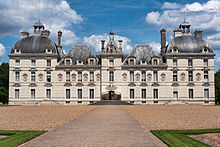- Château de Cheverny
-
The Château de Cheverny is located at Cheverny, in the département of Loir-et-Cher in the Loire Valley in France.
Contents
History
The lands were purchased by Henri Hurault, comte de Cheverny, a lieutenant-general and military treasurer for Louis XI, whose descendent the marquis de Vibraye is the present owner.
Lost to the Crown because of fraud to the State, it was donated by King Henri II to his mistress Diane de Poitiers. However, she preferred Château de Chenonceau and sold the property to the former owner's son, Philippe Hurault, who built the château between 1624 and 1630, to designs by the sculptor-architect of Blois, Jacques Bougier, who was trained in the atelier of Salomon de Brosse, and whose design at Cheverny recalls features of the Palais du Luxembourg. The interiors were completed by the daughter of Henri Hurault and Marguerite, marquise de Montglas, by 1650, employing craftsmen from Blois.
During the next 150 years ownership passed to many owners, and in 1768 a major interior renovation was undertaken. Required to forfeit much of the Hurault wealth at the time of the French Revolution, the family sold it in 1802, at the height of the Empire but bought it back in 1824, during the Restauration under Charles X. The aristocracy was once again in a very strong political and economic position.
In 1914, the owner opened the chateau to the public, one of the first to do so. The family still operates it, and Château Cheverny remains a top tourist attraction to this day, renowned for magnificent interiors and its collection of furniture, tapestries, and objets d'art. A pack of some seventy dogs are also kept on the grounds and are taken out for hunts twice weekly. A video of their feeding can be viewed [1].
Only a portion of the original fortified castle possibly remains in existence today. It is somewhat of a mystery, because to date there is no reliable way to prove whether or not a certain section is part of the original building. An ancient travelling artist captured the original castle in a drawing, but it contains no reliable landmarks, so the drawing offers no proof one way or the other.
Interior
The central Grand Salon on the ground floor was decorated under the orders of the marquise de Montglas. Among the paintings are a portrait of Jeanne d'Aragon, from the school of Raphael and a portrait of Marie Johanne de Saumery, comtesse de Cheverny by Pierre Mignard. A Gallery leads to the Petit Salon hung with five Flemish tapestries and a portrait attributed to Maurice-Quentin de La Tour. In the Library are hung portraits by Jean Clouet and Hyacinthe Rigaud.
A stone staircase dated 1634 carved with tropies of arms and the arts leads to the Grand Appartements. A guard room with a collection of arms and armour leads to the Chambre du Roi, richly hung with five Paris tapestries after designs by Simon Vouet, representing the story of Ulysses.
-
Château de Cheverny, detail of the facade
-
The hunting dogs at Château de Cheverny
Tintin
The Belgian comic book creator Hergé used Cheverny as a model for his fictional "Château de Moulinsart" (Marlinspike Hall in English) in the The Adventures of Tintin books.[1] In these books, the two outermost wings are not present, but the remaining central tower and two wings are almost identical.
Notes
- ^ "Tintin at Chateau Cheverny". Website of Chateau Cheverny. Château de Cheverny. http://www.chateau-cheverny.com/uk_tintin.php. Retrieved 30 June 2011.
External links
 Media related to Château de Cheverny at Wikimedia Commons
Media related to Château de Cheverny at Wikimedia Commons- Castle homepage
- Tintin room at the Castle
- Photos of Cheverny
- Photos of Château de Cheverny and other Loire castles
Coordinates: 47°30′01″N 1°27′29″E / 47.50028°N 1.45806°E
Châteaux of the Loire Valley Amboise • Angers • Azay-le-Rideau • Blois • La Bourdaisière • Chambord • Chaumont • Chenonceau • Châteaudun • Cheverny • Langeais • Loches • Menars • Montreuil-Bellay • Montsoreau • Plessis-Bourré • Le Rivau • Saumur • Sully • Talcy • Troussay • Ussé • Valençay • VillandryCategories:- Châteaux of the Loire Valley
- Châteaux in France
- Buildings and structures completed in 1630
- Buildings and structures in Loir-et-Cher
- Baroque buildings in France
-
Wikimedia Foundation. 2010.







